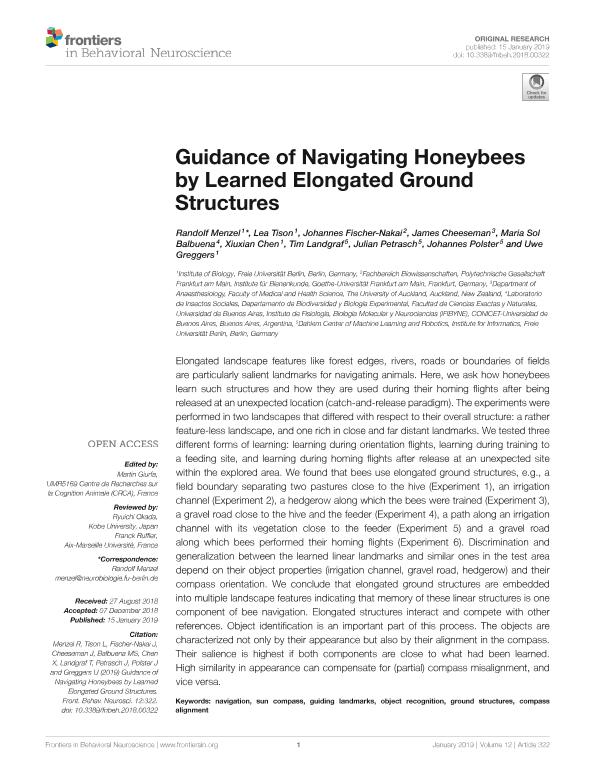Mostrar el registro sencillo del ítem
dc.contributor.author
Menzel, Randolf
dc.contributor.author
Tison, Lea
dc.contributor.author
Fischer-Nakai, Johannes
dc.contributor.author
Cheeseman, James
dc.contributor.author
Balbuena, María Sol

dc.contributor.author
Chen, Xiuxian
dc.contributor.author
Landgraf, Tim
dc.contributor.author
Petrasch, Julian
dc.contributor.author
Polster, Johannes
dc.contributor.author
Frau Verbauwede, Anabel Maria

dc.date.available
2020-12-22T13:39:30Z
dc.date.issued
2019-01
dc.identifier.citation
Menzel, Randolf; Tison, Lea; Fischer-Nakai, Johannes; Cheeseman, James; Balbuena, María Sol; et al.; Guidance of navigating honeybees by learned elongated ground structures; Frontiers Media S.A.; Frontiers in Behavioral Neuroscience; 12; 1-2019; 1-14
dc.identifier.issn
1662-5153
dc.identifier.uri
http://hdl.handle.net/11336/121025
dc.description.abstract
Elongated landscape features like forest edges, rivers, roads or boundaries of fields are particularly salient landmarks for navigating animals. Here, we ask how honeybees learn such structures and how they are used during their homing flights after being released at an unexpected location (catch-and-release paradigm). The experiments were performed in two landscapes that differed with respect to their overall structure: a rather feature-less landscape, and one rich in close and far distant landmarks. We tested three different forms of learning: learning during orientation flights, learning during training to a feeding site, and learning during homing flights after release at an unexpected site within the explored area. We found that bees use elongated ground structures, e.g., a field boundary separating two pastures close to the hive (Experiment 1), an irrigation channel (Experiment 2), a hedgerow along which the bees were trained (Experiment 3), a gravel road close to the hive and the feeder (Experiment 4), a path along an irrigation channel with its vegetation close to the feeder (Experiment 5) and a gravel road along which bees performed their homing flights (Experiment 6). Discrimination and generalization between the learned linear landmarks and similar ones in the test area depend on their object properties (irrigation channel, gravel road, hedgerow) and their compass orientation. We conclude that elongated ground structures are embedded into multiple landscape features indicating that memory of these linear structures is one component of bee navigation. Elongated structures interact and compete with other references. Object identification is an important part of this process. The objects are characterized not only by their appearance but also by their alignment in the compass. Their salience is highest if both components are close to what had been learned. High similarity in appearance can compensate for (partial) compass misalignment, and vice versa.
dc.format
application/pdf
dc.language.iso
eng
dc.publisher
Frontiers Media S.A.

dc.rights
info:eu-repo/semantics/openAccess
dc.rights.uri
https://creativecommons.org/licenses/by/2.5/ar/
dc.subject
COMPASS ALIGNMENT
dc.subject
GROUND STRUCTURES
dc.subject
GUIDING LANDMARKS
dc.subject
NAVIGATION
dc.subject
OBJECT RECOGNITION
dc.subject
SUN COMPASS
dc.subject.classification
Otros Tópicos Biológicos

dc.subject.classification
Ciencias Biológicas

dc.subject.classification
CIENCIAS NATURALES Y EXACTAS

dc.title
Guidance of navigating honeybees by learned elongated ground structures
dc.type
info:eu-repo/semantics/article
dc.type
info:ar-repo/semantics/artículo
dc.type
info:eu-repo/semantics/publishedVersion
dc.date.updated
2020-11-13T20:49:39Z
dc.journal.volume
12
dc.journal.pagination
1-14
dc.journal.pais
Suiza

dc.description.fil
Fil: Menzel, Randolf. Freie Universität Berlin; Alemania
dc.description.fil
Fil: Tison, Lea. Freie Universität Berlin; Alemania
dc.description.fil
Fil: Fischer-Nakai, Johannes. Goethe Universitat Frankfurt; Alemania
dc.description.fil
Fil: Cheeseman, James. University of Auckland; Nueva Zelanda
dc.description.fil
Fil: Balbuena, María Sol. Consejo Nacional de Investigaciones Científicas y Técnicas. Oficina de Coordinación Administrativa Ciudad Universitaria. Instituto de Fisiología, Biología Molecular y Neurociencias. Universidad de Buenos Aires. Facultad de Ciencias Exactas y Naturales. Instituto de Fisiología, Biología Molecular y Neurociencias; Argentina
dc.description.fil
Fil: Chen, Xiuxian. Freie Universität Berlin; Alemania
dc.description.fil
Fil: Landgraf, Tim. Freie Universität Berlin; Alemania
dc.description.fil
Fil: Petrasch, Julian. Freie Universität Berlin; Alemania
dc.description.fil
Fil: Polster, Johannes. Freie Universität Berlin; Alemania
dc.description.fil
Fil: Frau Verbauwede, Anabel Maria. Freie Universität Berlin; Alemania
dc.journal.title
Frontiers in Behavioral Neuroscience
dc.relation.alternativeid
info:eu-repo/semantics/altIdentifier/doi/http://dx.doi.org/10.3389/fnbeh.2018.00322
dc.relation.alternativeid
info:eu-repo/semantics/altIdentifier/url/https://www.frontiersin.org/articles/10.3389/fnbeh.2018.00322/full
Archivos asociados
